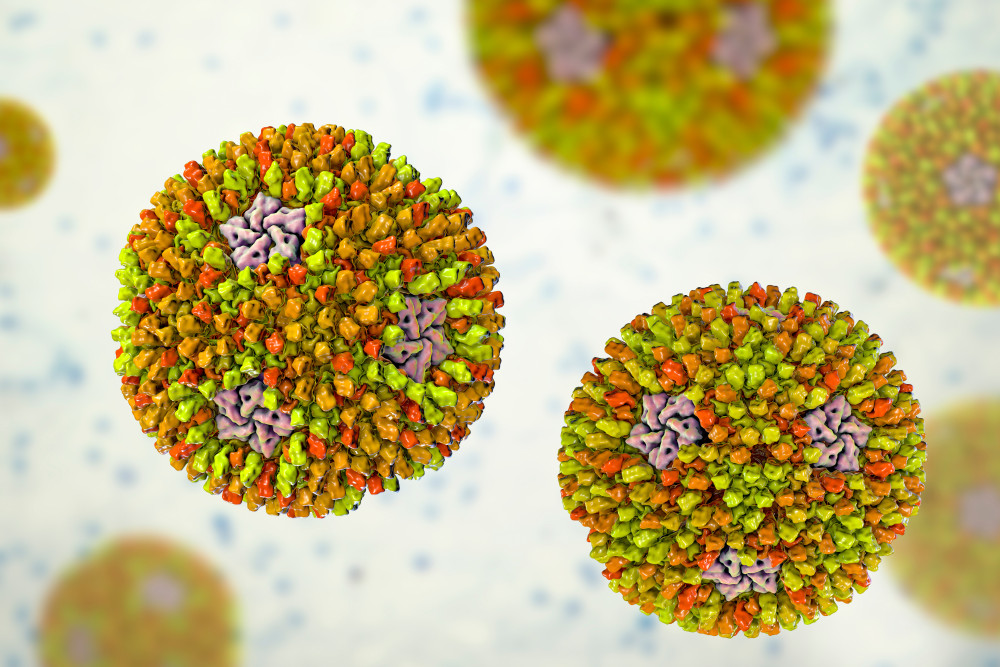Avian Reovirus is widely disseminated in commercial poultry farming. It is estimated that 85 to 90 % of reovirus strains are not pathogenic. However, pathogenic strains can cause a wide variety of symptoms including viral arthritis, tenosynovitis, respiratory and enteric disease, myocarditis, and hepatitis.
Avian Reovirus was isolated for the first time in 1954 and later in 1968 was associated with clinical signs of arthritis and tenosynovitis. Affected birds showed signs of edema of the hock and digital flexor tendon, with rupture of the gastrocnemius tendon. In 1983, commercial vaccines were developed and very efficient in controlling Reovirus in poultry farming. However, in 2011 new variant strains emerged that were genetically very different from known strains. The new variants caused enormous losses to commercial poultry farming worldwide.
Viral Structure
The reovirus genome is double stranded, non-enveloped, segmented RNA. The genome has 10 segments divided into 3 categories according to their size. Each segment encodes proteins including Sigma C which plays a very important role in identifying and binding to the target cell receptor. Sigma C is hypervariable, and variants can be identified by sequencing this protein.
Reovirus is stable at pH values between 3.0 and 9.0 and is inactivated at 56°C in less than an hour. Regarding disinfectants, it is relatively resistant and can survive for 10 days in feathers, wood shavings, eggshells, and food. Reports indicate that some strains are resistant to ether and 2 % formalin.
Genetic Diversity
The emergence of new variant strains of reovirus occurs when there is genetic rearrangement from 2 parental genomes infecting the same host cell. New strains contain genomic mutations, promoting genetic diversity. Despite the extensive knowledge of the mechanisms of viral replication, it is not yet known why the appearance of new pathogenic variants was limited before 2011. Researchers are seeking to understand why in the last decade, the Reovirus that causes viral arthritis has become so dynamic in its ability to produce variant strains so quickly.
Infection and Dissemination
Reovirus infects chickens, turkeys, ducks and other avian species distributed around the world. Meat-producing birds are more susceptible to viral arthritis than layers and breeders, due to the former presenting characteristics of rapid weight gain. Moreover, the development of immunity in broilers is slower when compared to commercial laying birds.
Reovirus is transmitted horizontally and vertically. The natural route of infection is fecal-oral. The virus is excreted through the intestine and respiratory tract, with intestinal dissemination occurring over longer periods. Vertical transmission is more limited and generally attributes about 2% of infections and occurs between 17 and 19 days after infection. Parents positive for avian reovirus may have poor performance including low hatchability and an increase in early chick mortality.
Arthritis and Tenosynovitis
Viral arthritis/tenosynovitis is one pathological manifestations of infection with different serotypes and pathotypes of Reovirus. It can be the direct cause or in combination with other pathogenic agents such as Mycoplasma and Staphylococcus.
Viral arthritis and tenosynovitis are diseases predominantly of broilers, but it can occur in breeders, causing weak legs. The disease can occur in commercial table egg birds, but less frequently. The incubation period differs depending on the virus pathotype, host age and exposure, and can vary between 3 to 14 days.
The main clinical sign of arthritis and viral tenosynovitis is swelling of one or both hock joints (tibiotarsus-tarsometatarsus), causing acute lameness in chickens aged between 4 to 7. It may go unnoticed in the field and observed at processing. Morbidity generally does not exceed 10 % and the mortality rate is low but varies according to the viral pathogenicity.
Afflictions caused include edema and inflammation of the hock and in more severe cases there is rupture of the gastrocnemius tendon with or without erosion of the joint capsule. Tendon rupture is accompanied by the presence of hemorrhaging which can be seen as a greenish color in the hock region.
Scientific evidence indicates that younger birds are susceptible to reovirus infection. Birds inoculated early showed a higher prevalence of clinical signs and mortality when compared to birds inoculated at an older age. Because Reovirus is age dependent, young flocks at processing may have high percentages of condemnations due to arthritis.
The presence of the virus in tissues does not always correlate with the appearance of clinical signs and macroscopic lesions. Viral shedding occurs for 3 weeks in chickens and viremia (viral circulation in the blood) occurs for 10 days after infection. The appearance of microscopic lesions occurs between 6 to 8 days after infection by highly virulent strains of Reovirus that cause tenosynovitis. These microscopic lesions remain throughout life. As the bird gains weight, microscopic lesions become macroscopic with lameness and hock edema occurring.
Immune Response
Avian Reovirus has a specific group antigen and serotype. Neutralizing antibodies circulate between 7 to 10 days post infection and in relation to early immunity, (the detection of) maternal antibodies can be detected in broiler chicks as early as the 1st day of age, facilitating evaluation and efficiency of vaccination programs. Birds presenting high levels of maternal antibodies combined with a program of live and inactivated vaccines demonstrate a good response to infection and fewer clinical signs of Arthritis/Tenosynovitis.
Prevention and Control
The virus can be transmitted horizontally and vertically, so strict biosecurity is extremely important to prevent flock contact. Likewise, good sanitation and a thorough cleaning and disinfection program with virucidal disinfectants are important to prevent and control the pathogen.
Vaccination
Vaccination programs to prevent and control viral arthritis have been designed to produce high levels of anti-reovirus neutralizing antibodies. These antibodies aim to directly protect birds and also the progeny through the transfer of maternal antibodies for rapid and early protection.
Typically, programs apply multiple doses (3) of inactivated vaccines up to 12 weeks, starting one targeted virus strain at hatch and vaccinating against other strains afterwards. From 12 weeks on, the program typically continues with more doses of inactivated vaccine (1 to 3) and may broaden to vaccinate against additional strains.
The emergence of variant strains related to viral arthritis and the increase in leg condemnations in slaughter plants has led companies to search for autogenous vaccines, using isolates from affected birds to develop customized products. This practice has proven to be quite efficient. However, autogenous vaccines require periodic updating of the strains circulating in the field. The material for preparing these vaccines must come from infected leg joints and is typically updated every 4 to 6 months. Vaccination against a combination of prevalent field strains provides broad-spectrum protection.
Diagnosis
Viral isolation is indicated in cases of affected birds with the appearance of clinical signs of arthritis, as it indicates a causal relationship. Molecular techniques using RT-PCR have been used widely to identify Reovirus, as it is fast, specific and sensitive. Through molecular sequencing, it is possible to determine, different groups, genotypes or whether a new strain was introduced to a flock or disseminated across several flocks.
Serological methods are quite popular and affordable for determining antibody titers after vaccination or field challenges. The ELISA assay has been used as a screening tool. However, the value this test to diagnose the disease has been limited, because there are typically more than one serotype circulating in flocks, some of which may not be pathogenic.
Issues observed at plants
The lesions evident at processing plants, which lead to condemnations, can be mild, with little swelling in one or both joints, joint blisters containing liquid that vary in color from clear, bloody or purulent, tendon rupture and acute inflammatory processes.
In all situations, the losses to the poultry industry are significant. In addition to the loss of discarded legs, the processing speed of flocks with problems must be reduced to remove carcasses from the line.
Conclusions
Reovirus infections can have a significant economic impact on a producer. A strict biosecurity program along with broad spectrum vaccinations are the best tools to reduce the risk of and control infection. Flocks can also be tested regularly which will facilitate early detection and intervention.


